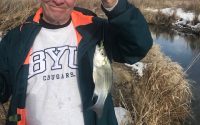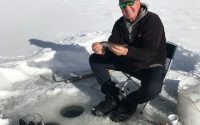Detecting The Strike
by Don Allphin
July 18, 2005
A reader writes, “I’m new to nymphing for trout and am having problems recognizing when to set the hook. Can you give me some suggestions?”
Detecting a strike in moving water is one of the most challenging aspects of fly fishing. And, don’t let the veterans tell you they feel each strike they get, it just doesn’t work that way. Studies have shown that anglers detect only a small fraction of the actual strikes they get. So, first and foremost, don’t beat yourself up over missing a fish or two – everyone does.
The best possible way to illustrate the problem of detecting strikes while nymphing is to watch trout as they feed. This can be done on almost any clear stream by getting above the water, either on a bridge or on top of a steep bank. Then, after putting on your Cocoon sunglasses (polarized), simply note how they eat. We picture in our mind’s eye a trout slamming into our fly with abandon because at times they do just that. But most of the time, trout allow the current to act as a food conveyor, sort of like a buffet tray that parades in front of them. They make their selection, position themselves downstream and merely open their mouths. If a No. 22 Brassie drifting above a split-shot and moving with the current is a trout’s choice of food, you might never actually “feel” the strike.
Take heart, however, because you can learn to detect strikes in other ways.
Most nymphing rigs include two nymphs, one tied on the main tippet and a second or “dropper” tied on a leader to the back of the hook of the first fly, and a split-shot or two placed above both flies. In most cases, you should “feel” the weight as it moves downstream, or you at least want to know that the weight is moving along the bottom. So, when the line stops, hesitates, or changes in any way during the drift — set the hook. Sure there will be times there won’t be a fish on the line, but it’s better to be safe than sorry.
Placing a strike indicator (found in any fly shop) on the line will also help you watch your line as it drifts. Look for any changes in the drift and once again, don’t be afraid to set the hook.
Remember that nymphing is a skill to be developed the same as casting; and as a result, time on the water is the best teacher when learning when to set the hook.











